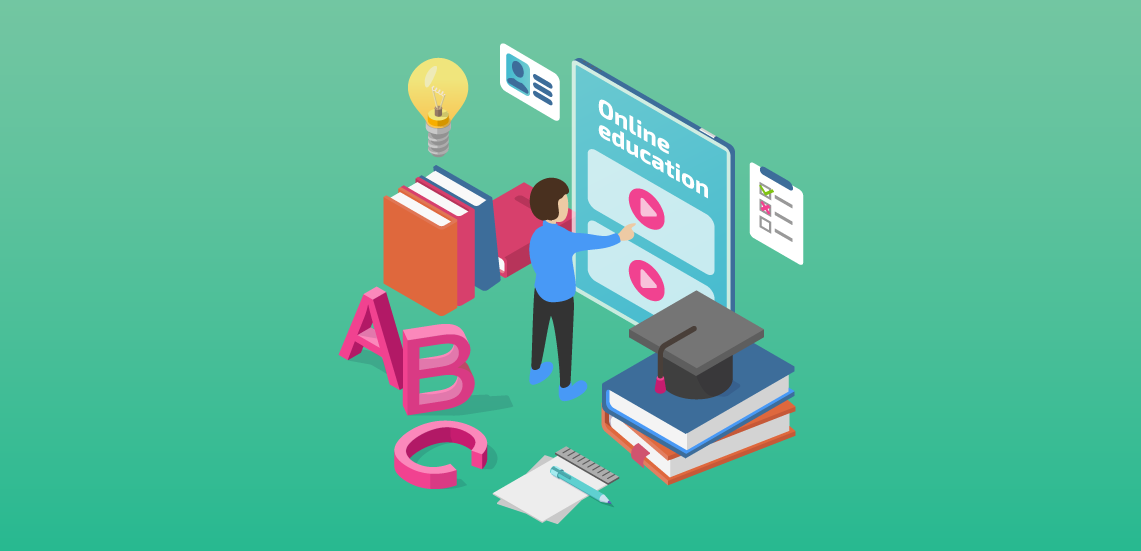Student autonomy in the classroom is essential for efficient learning. Teachers should support and encourage it all the while without ignoring the importance of communication and teamwork.
Students need to be able to learn at their own pace to better grasp and retain information Self-paced, personalized learning allows them to gradually accumulate knowledge and competencies according to their needs and level.
Student autonomy in the classroom is important both for learners and teachers. It helps them find a balance between frontal lessons and individual study, interaction and reflection, formal evaluation and self-assessment.
Today’s educational technology makes it easier to support student autonomy in the classroom and beyond it. One of the most popular tools that achieve this goal is the learning management system (LMS). Learn how your school LMS can empower students and help them become efficient autonomous learners.
Why is student autonomy in the classroom so important?
The benefits of student autonomy in the classroom and, in general, in life, are undeniable. For example, an independent student will be better equipped to face personal and professional challenges without constantly relying on others.
At the same time, each student has a different learning pace. For teachers, it's next to impossible to adapt to each student's needs without allowing them to learn autonomously. Autonomous learning boosts their:
- Sense of independence;
- Time-management skills;
- Confidence;
- Problem-solving skills;
- Logical thinking.
More autonomy also makes learning more engaging and effective. It prevents boredom and also helps teachers find the right pace for their classes and avoid burnout. Allowing students to take more ownership of their learning allows teachers to take a break for a bit.
Student autonomy in the classroom is also essential for their future careers. Working independently and being able to self-manage are must-have abilities for today's employees.
Equipping students with future-ready skills is one of the main aspects educational institutions should focus on nowadays. Preparing students for their future jobs by teaching them how to effectively learn on their own builds a reliable and skilled workforce.
How to encourage student autonomy in the classroom
There are myriad ways to promote student autonomy in the classroom and beyond, especially if you use an LMS. Here are a few common strategies that support student autonomy.
Flipped classes
The flipped classroom allows students to acquire new concepts at home via engaging videos, online courses, or even game-based learning. Thus, more classroom time can go toward communication, debate, teamwork, and other group activities that support social learning.
Team and individual projects
Asking students to complete and deliver a project within a strict deadline is a great way to boost their time-management skills, ability to prioritize, and in the case of group projects – collaboration skills. Projects are easier to organize, assign, and track thanks to digital tools, especially if teachers use various LMS features such as team assignments.
Personal goals
Setting learning and personal goals is another habit that will help students become more independent. Goals offer a structured approach to learning. They help track their progress, pinpoint student weaknesses and strengths, and continuously improve. Therefore, it's important to teach students how to set goals, track, and achieve them.
Self-evaluation
Self-evaluation is intrinsic to learning autonomy.Together with teacher evaluation, it plays an essential role in enabling students to become self-aware, grounded, and results-oriented learners. Quizzes are among the LMS features that make self-evaluation easy, and we'll tell you more about them in a bit.
Student feedback
Student feedback improves your teaching skills and enhances student-teacher communication, given that successful teaching relies on 50% knowledge and 50% communication skills. Feedback also helps students gain more ownership in their learning. By communicating their wants, needs, and concerns, they become more involved in what is happening in the classroom.
Autonomy-supportive teachers regularly ask for student feedback and adapt their classes, evaluation method, and expectations accordingly.
Read more: 9 Characteristics of authentic learning
Eight LMS features that support student autonomy
LMSs have been around for years, but they're constantly evolving and adding new features that further ease teachers’ jobs and make learning more exciting for students. Some of these systems are now turning into intelligent learning platforms that provide next-level content recommendations and track and tweak their content based on user behavior.
They don’t only help educators teach and assess students. They also support students’ self-paced learning needs, their ability to self-assess their skills and provide access to the most suitable content based on their goals, and interests.
Here are the top eight LMS features that support student autonomy in the classroom:
1. Competency-based learning and automation
Student autonomy is not just about letting students learn at their own pace. It’s also connected to competency-based learning. With an LMS, teachers can design classes, resources, and assessments according to their students’ capabilities. This is done by associating competencies (or student skills) to the content students have to learn.
For example, geography classes can have associated competencies related to:
- US climate: recognizing the types of climate in the US);
- US surface: knowing the overall surface of the US and that of specific states;
- Natural phenomena: distinguishing the major natural phenomena and their causes;
- Meteorology: knowing the most important stages of the weather forecast.
Each competency can also be associated with an assignment students have to complete on the platform to get graded. Once they log in, students can see the competencies they’ve already mastered and those they haven’t.
A student who had trouble understanding meteorology and was unable to pass the test at the end of the meteorology class, can resume that class and take the quiz again. They will see in real-time their results, so they can re-take the assessment as many times as needed. The teacher sees the student’s progress on the platform and wastes no time checking their test as it is automatically graded.
Only after the student has managed to complete the quiz, the platform unlocks the next class or module. So, they basically have to prove they master certain skills to be able to progress. Competency-based learning is a learner-centered, autonomous, and automated learning process if you use an LMS.
Read more: How to write SMART learning objectives in your LMS
2. Personalized learning paths
Student autonomy in the classroom is also enabled by designing personalized learning paths in the LMS. Learning paths are personalized learning flows that allow students to gradually progress.
Learning paths are flexible in an LMS. They allow you to mix class sections with a variety of resources and content from other classes. You can add assignments, challenges, and gamification features such as trophies and certificates along the way. Learning paths promote student autonomy because they are:
- Personalized according to each student’s level;
- Flexible, as you can constantly adapt them and make them more complex;
- Require autonomy as each student has their individual path.
As they move along the learning path, students acquire and demonstrate new knowledge in a personalized and engaging way. They also have the chance to see their progress and figure out how much time and steps they still need to take to complete a path.
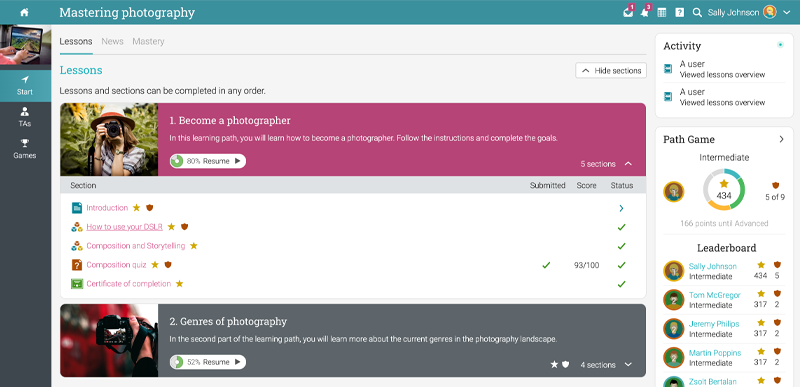 Personalized learning paths encourage students to reach their learning goals and adapts to their needs.
Personalized learning paths encourage students to reach their learning goals and adapts to their needs.
3. Auto-graded quizzes
Student autonomy is tightly connected to students’ ability to self-assess their skills. LMSs support student self-evaluation via different types of assessments such as quizzes and essays.
You can set them up in minutes and once students complete them, you’ll simply have an overview of their grades in your digital grade book.
Auto-graded quizzes are an excellent way to help students quickly figure out what their level is based on the scores they get after completing each quiz. You can allow students to take a quiz multiple times or just once and set a certain number of attempts. This allows you to set certain assessment standards based on your expectations and students’ level.
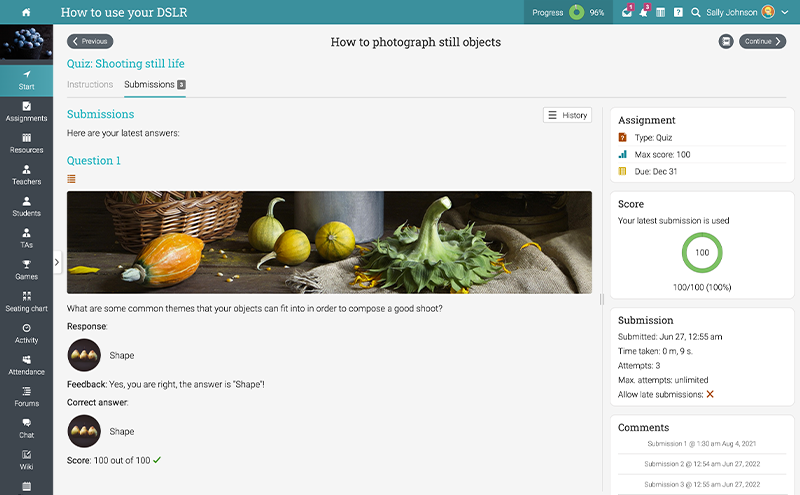 Auto-graded quizzes are among the most common and useful tools for self-assessment.
Auto-graded quizzes are among the most common and useful tools for self-assessment.
Read more: 9 Types of assignments teachers can create in their LMS to evaluate student progress
4. Surveys
Surveys encourage students to self-reflect, analyze, and express themselves. You can create surveys on various topics depending on what you aim for. You can even create a survey to assess students’ autonomy necessities. It can include questions such as:
- How many hours a week do you dedicate to independent study?
- Do you prefer learning on your own or in the classroom?
- Do you think classes should focus more on independent learning activities?
- To what degree do you consider yourself an efficient autonomous learner?
Surveys help teachers understand their students’ needs, wants, and motivations. They help them tweak their classes accordingly and provide students with the level of learning autonomy they truly need.
5. Ratings and reviews
Students can rate the classes they take in an LMS. This feature is not only useful for teachers because it helps them create more engaging class content. It also promotes student autonomy as learners see the classes and resources their classmates found more appealing. So, they can access those resources directly and enjoy the most suitable content for their needs based on other students’ opinions.
An LMS class rating can be displayed as a five-star system. Students can also write a review to help others understand what they can expect from a certain class.
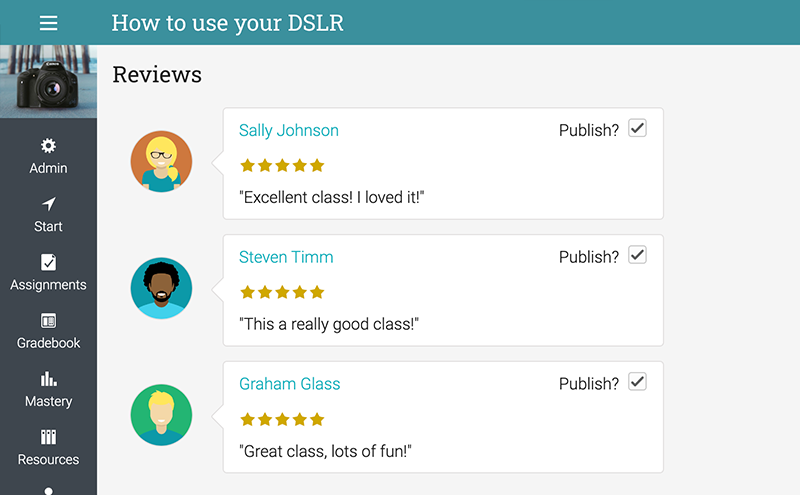 Students can give feedback through class ratings and reviews.
Students can give feedback through class ratings and reviews.
6. AI recommendations and personalized goals
AI recommendations are part of the LMS features you can find in more advanced systems that have migrated toward intelligent learning platforms. AI recommendations are powered by robust artificial intelligence algorithms that track user behavior to suggest the most appropriate content.
This recommendations system is not new. You’ve probably seen it dozens of times before, in e-commerce for example. If you buy something from an online shop or marketplace, the next time you log into your account, you’ll automatically see recommended products resembling your latest purchase.
This is how an LMS also sends personalized recommendations to students aiming to help them find the best educational content for their level and needs. These accurate recommendations can help students progress faster in their self-paced study and close their learning gaps with the help of edtech.
Students have the freedom to decide which recommendations to take. They can also rate recommendations, using the same five-star system that’s available for class ratings, and even dismiss recommendations. Therefore, they get plenty of autonomy in choosing the resources they want to use based on their learning goals. These recommendations can help students
- Save time on looking for resources on their own;
- Get instant access to tailored content;
- Enjoy a variety of resources.
Not all the recommended content the LMS provides has to come from school classes. Intelligent learning systems connect to the world wide web, so they can provide third-party content recommendations such as articles or essays from different websites.
7. Communication features
Features such as groups, chats, and forums are great ways to promote student collaboration in digital spaces. You might wonder why this feature is included among a series of LMS tools that aim to boost student autonomy instead.
Well, communication features also aid student autonomy. They do this by helping students engage in self-study easier. Whenever a student encounters a problem and needs help, they can quickly write a question in a group or chat and get an answer from a colleague or teacher almost instantly. These LMS features allow teachers to gather different resources and make it easier for students to access them in one place, while also enabling them to stay up-to-date with their goals and assignments.
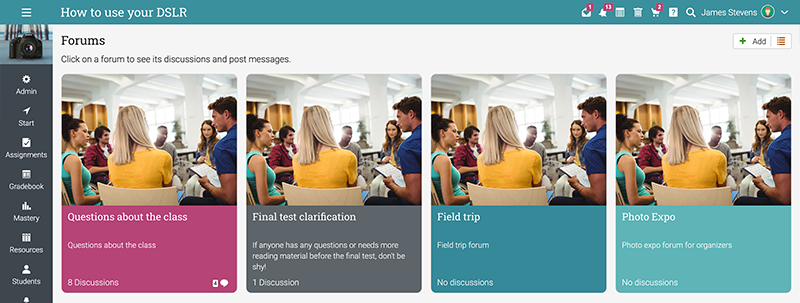 Communication tools such as forums are great for discussing lessons, asking questions, or upcoming activities.
Communication tools such as forums are great for discussing lessons, asking questions, or upcoming activities.
Read more: How LMS groups enable student collaboration for better learning outcomes
8. Digital portfolios
Digital portfolios enable students to keep a record of their work. Here, they can include their most important projects, essays, and other materials they’ve been working on individually. Each student gets a digital portfolio in the LMS. They can access it at any time to upload the work they’re most proud of, so they can showcase it to teachers or parents. Students can easily organize their digital portfolios into different folders for each class.
Portfolios are a great way to start building a professional mindset. It helps students evaluate their progress and pick the results they’re most proud of, an approach they will later apply to their line of work, especially if they want to become freelancers or start a company. Digital portfolios boost students’ self-analysis skills, as well as their self-confidence by enabling them to re-evaluate their work.
Supporting student autonomy in the classroom and beyond
Autonomy in the classroom is essential, especially in the post-lockdown world that sees a great shift in how people work and study. If communication and collaboration skills were highly valued before the pandemic, many employers now understand the importance of autonomy, good self-management, and self-assessment skills. All these are areas students need to improve in school so they can be prepared for tomorrow’s competitive work environment.
Thanks to their robust features, LMSs promote autonomous study in various ways. Thus, they boost students’ critical thinking skills, help them evolve at their own pace, and constantly self-evaluate their knowledge and competencies.







